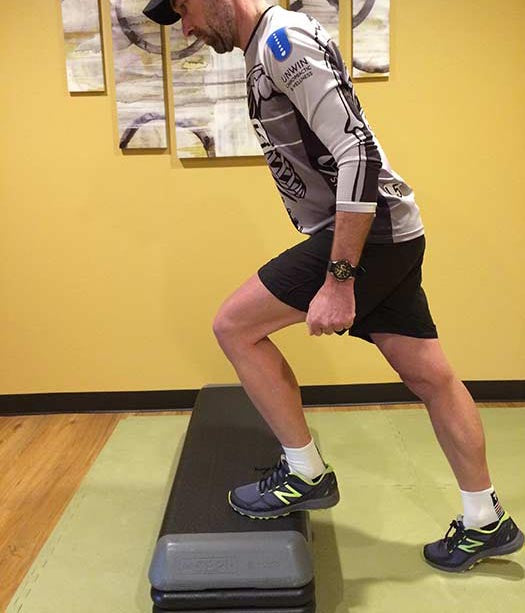By: Lee Unwin, Certified Strength & Conditioning Specialist
Most cyclists realize that strength training plays a crucial role in increasing their cycling performance. However, if the idea of spending time lifting weights is just too painful to think about, this article may be for you. Below I demonstrate the most important exercises you need for increasing your cycling performance and break down how to perform these motions in a cycling specific manner.
Down Stroke: Quads
The step-up is one of the best ways to improve cycling strength. To find the maximum box height, place the step so that your torso, thigh angle and lower leg angles are the same, or as close to the same, angles as when standing on the bike with the pedals at the 1 and 7 o’clock positions.
My preference is to lower the box height two or three times during the workout. I feel this works the power delivery point of the down stroke much better than leaving the box at a constant height. To complete a full range of motion, lift the heel to engage the calve muscle.



Pull-Through Stroke: Hamstrings & Gluteus
Affix a workout tube around an anchor, raise the stabilizing leg at least 3-inches off the ground. When the pulling leg is extended out to the 5 or 7 o’clock position, the tube should have slight tension on it.
Just like your cycling stroke, pretend that you are scraping mud off the bottom of your shoe, pull flat across the bottom, keeping a slight bend to the knee and press back as far as you can. While performing this exercise lean slightly forward to replicate the riding position.






Upstroke: Hip Flexor
First turn around, then start with slight tension at the 6 o’clock position, begin the movement by driving the knee upward and slightly forward. This should be a similar motion to the upstroke while standing.
One variation is to stand with a weight on the foot, lifting the knee straight up. This can be done standing on a riser or on the ground.



Riding Position: Core
To better strengthen the riding position, try a modified plank. For those using aero bars place the elbows directly under the shoulders, keeping your spine in alignment, drive the
knee forward alternating throughout. For those riding road or mountain bike place the arms in the same position as your bars, be sure to keep a slight bend to the elbows.
As an alternative to traditional sets and reps, try going for time. Perform each exercise for a minute, as you get stronger start to increase your time.




With this routine, you won’t need to spend hours at the gym. Twenty to thirty minutes, two to three times per week is more than sufficient.
As a cyclist myself, I know that we’re creatures of time, not sets. For this reason, I’ve moved my athletes away from traditional reps and sets, and instead focus on performing each lift for time, typically 30-seconds to 3-minutes. On shorter durations days (ie., 30-seconds to 1-minute), try heavier weights that have you almost or completely fatigued at the end.
For longer duration days (i.e., longer than 1-minute), try starting with a heavier weight and reducing in weight throughout the lift OR start with a lighter weight that you can just barely finish within the allotted time.
In between movements, keep the transitions short and keep moving. While this isn’t a cardio workout, why not keep the heart rate up and get back to the fun stuff - like riding.

Lee Unwin received BA Exercise Science at St. Ambrose University. He is a Certified Strength & Conditioning Specialist as well as a Board Certified Massage Therapist.
Alongside his wife, Lee owns and operates Unwin Chiropractic & Wellness Center and the Verona Fitness Studio, in Verona, Wisconsin. He has over 20 years of experience working athletes. Lee also competes in marathon mountain biking and cyclocross, both locally and nationally.
